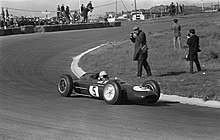Lotus 24
The Lotus 24 was a Formula One racing car[1] designed by Team Lotus for the 1962 Formula One season. Despite some early success in non-Championship Grands Prix, it was eclipsed by the technically superior Lotus 25 and rarely featured in the points in World Championship races.
.jpg) Lotus 24 BRM at the Silverstone Classic in 2018. Miles Griffiths - Hi-Tech Motorsport | |||||||||||
| Category | Formula One | ||||||||||
|---|---|---|---|---|---|---|---|---|---|---|---|
| Constructor | Team Lotus | ||||||||||
| Designer(s) | Colin Chapman | ||||||||||
| Predecessor | 21 | ||||||||||
| Successor | 25 | ||||||||||
| Technical specifications | |||||||||||
| Chassis | Steel spaceframe | ||||||||||
| Suspension (front) | Double wishbone, with inboard coilover spring/damper units. | ||||||||||
| Suspension (rear) | Lower wishbone, top link and radius rod suspension, with outboard coilover spring/damper units. | ||||||||||
| Engine | Coventry Climax FWMV, 1496cc, 90° V8 BRM P56, 1498 cc, 90° V8 Naturally aspirated mid-mounted | ||||||||||
| Transmission | ZF 5DS10 5-speed manual | ||||||||||
| Tyres | Dunlop | ||||||||||
| Competition history | |||||||||||
| Notable entrants | Team Lotus Brabham Racing Organisation UDT Laystall Racing Team Siffert Racing Team | ||||||||||
| Notable drivers | |||||||||||
| Debut | 1962 Dutch Grand Prix | ||||||||||
| |||||||||||
| Constructors' Championships | 0 | ||||||||||
| Drivers' Championships | 0 | ||||||||||
| n.b. Unless otherwise stated, all data refer to Formula One World Championship Grands Prix only. | |||||||||||
Concept
Having devised the monocoque Lotus 25 for use by the works team, Colin Chapman decided to build a 'conventional' back-up spaceframe design which he would also sell to privateers. The 24 was a completely different design from its predecessor, the 21, and used much of the same suspension as the 25. Both Coventry Climax FWMV and BRM P56 engines were generally fitted, with at least one example running with the Coventry Climax FPF four-cylinder.
Racing history

The Lotus 24 made its debut at the 1962 Brussels Grand Prix. Jim Clark put it in pole position for the first heat, but retired after only one lap. Two weeks later Clark won the Lombank Trophy race at Snetterton. Its first World Championship event was the 1962 Dutch Grand Prix, where it finished second with Trevor Taylor. However, that would be its best Championship finish; the Lotus 25 had arrived on the scene and was obviously the way ahead, much to the chagrin of those who had paid good money for their 24. Colin Chapman had promised his customers that the team cars would be mechanically identical to the customer cars, leaving himself free to alter what he classified as the cars' "bodywork".[2]
The 24 continued to be run by private teams in 1963 and 1964 with limited success, and by 1965 only one World Championship entry was made, Brian Gubby failing to qualify for the British Grand Prix.
World Championship results
(key) (results in bold indicate pole position; results in italics indicate fastest lap)
Notes
- Points were awarded on a 9-6-4-3-2-1 basis to the first six finishers at each round, but only the best placed car for each make was eligible to score points. In 1962 only the best five results from the season were retained, and only the best six results for 1963, 1964 and 1965.
- Total points scored by all Lotus-BRM cars, including points scored by drivers of Lotus 25 and Lotus 33 variants.
- Total points scored by all Lotus-Climax cars, including points scored by drivers of Lotus 25 and Lotus 33 variants.
Bibliography
- Whitelock, Mark (2006). 1½-litre Grand Prix Racing 1961-1965. Veloce Publishing Ltd. ISBN 184584016X.CS1 maint: ref=harv (link)
References
- Automobile Year, No. 10, 1962-1963, Page 198.
- Blunsden, John (July 1962). "Lotus "Ramlösa" - Segervagnen i Spa" [Lotus' Frameless: the Victory Machine at Spa]. Illustrerad Motor Sport (in Swedish). No. 7–8. Lerum, Sweden. pp. 6–7.
| Wikimedia Commons has media related to Lotus 24. |